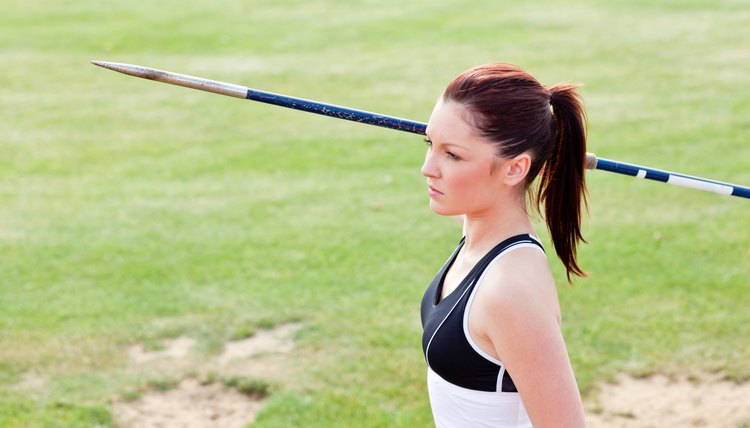The Role of Bones, Joints & Muscles for the Javelin Throw

A strong, healthy musculoskeletal system is needed for participating in the javelin throw. Components of the musculoskeletal system -- bones, joints and muscles -- play a number of major roles in the javelin throw, including enhanced endurance, strength, speed and mobility. Javelin throwing is not for everyone and requires immense practice, determination and fitness. Consult your doctor before taking up javelin throwing.
Facts
The javelin throw is a high-endurance activity that involves the entire body in a movement that resembles throwing a spear. Upper-body strength and flexibility are needed to lift, carry and throw the javelin at high speeds. Abdominal, or core, strength and flexibility rotate the body during the throw. Lower body strength and mobility provide a solid base upon which the throw can be efficiently and accurately accomplished.
Muscles
Muscular strength and endurance are essential in javelin throwing. Healthy, strong leg muscles are necessary to increase momentum and achieve the high-intensity sprinting that leads up to an efficient throw. Upper arm and shoulder muscle endurance and mobility play a role in determining the throwing speed and form. Lower arm muscles, including the hands, increase javelin grip strength while improving throwing velocity. Properly conditioned heart and lung muscles are necessary for the sprinting action and intense breathing involved in a javelin throw. Strong abdominal muscles provide a foundation for turning the upper body in preparation of the throw and for increasing the throwing distance.
Joints
To perform a javelin throw properly and decrease the risk of injury, joints need to be strong and flexible, with a full range of motion. Flexible shoulder joints are required to bring the javelin-holding arm back over the head in preparation for the throw, with the javelin tilted upward. The shoulder joint rotates to bring the javelin forward during the release. A strong and flexible elbow is needed to release the javelin during the throw sequence properly and quickly. Proper form plays an essential role in preventing injury. Leg joints, including the hip, knee and ankle, must be flexible to allow an intense level of sprinting, bracing the body and anchoring the throw.
Bones
Javelin throwing could not be done without healthy, strong bones. Leg bone density and strength are required to accomplish the high speeds needed during the sprinting stage, prior to the javelin throw. Strong leg bones carry the body's weight and properly anchor it before throwing the javelin. Strong arm bones increase the efficiency of motion when holding, lifting and throwing the javelin.
Considerations
Different items need to be taken into consideration while preparing for a javelin throw. Proper form plays a major role in determining acceleration and velocity levels and in preventing injuries, such as elbow or shoulder misalignment. Consider mentally noting whether your elbow is in alignment with your shoulder to avoid throwing at an incorrect angle.
References
Writer Bio
Crystal Welch has a 30-year writing history. Her more than 2,000 published works have been included in the health and fitness-related Wellness Directory, Earthdance Press and Higher Source. She is an award-winning writer who teaches whole foods cooking and has written a cookbook series. She operates an HON-code-certified health-related blog with more than 95,000 readers. Welch has a B.B.A. from Eastern Michigan University.
